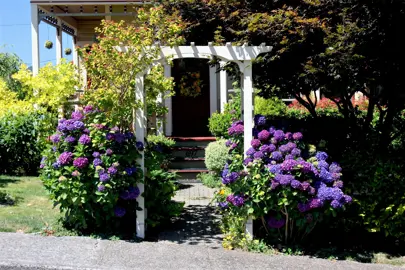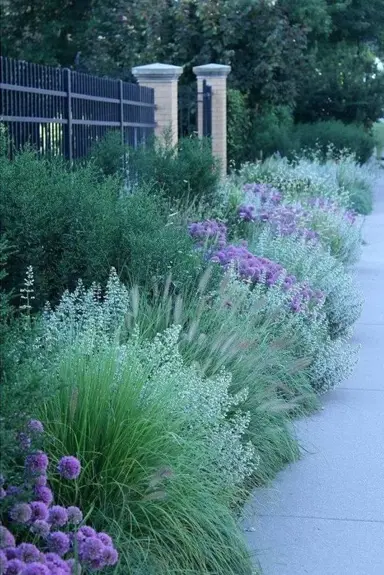How Fast Do Agapanthus Grow?
Agapanthus are generally vigorous, establish quickly, and will double in size each year. Be sure to start with strong and healthy plants at the outset.
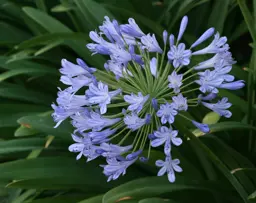
Agapanthus are a staple in many New Zealand gardens thanks to their hardiness, striking flowers, and low maintenance. Whether you’re looking to plant them in mass displays or as borders, Agapanthus thrive in most NZ climates and require minimal upkeep. This guide covers everything from planting and care tips to the best varieties for Kiwi gardens.
Agapanthus care in NZ is about making sure the plants are thriving. Our plant care articles provide the necessary details to give you the greatest chance of success. Afterall, there is nothing worse than putting the effort into planting for them to fail. Therefore, follow our advice for Agapanthus care and give yourself the best chance of success.

Agapanthus are generally vigorous, establish quickly, and will double in size each year. Be sure to start with strong and healthy plants at the outset.

Agapanthus sold by nurseries typically reach 60 cm tall and the same wide, though this obviously depends on the growing conditions and the variety. Dwarf Agapanthus varieties such as Agapetite will only grow to 15 cm tall and the same wide. The Plant Company has put a lot of effort into determining how big each plant will grow in an unrestricted growing environment. Far too often we see people planting a garden too densely and then having to spend a lot of time trimming or removing plants later. This is something we want our customers to avoid and we therefore provide size information so the planning can be right from the start. Be sure to check out our Agapanthus and the detailed information that accompanies both this and our other plants.

The most important part starts with planting, and our article, How To Plant Agapanthus, provides sound advice on how to do this properly. So, let’s now assume your plant is growing well and you want to keep it that way!
Winter is the perfect time for mulching your plants. Organic matter such as compost or sheep pellets should be spread liberally around the plants and then overlaid with mulch. The Plant Company has three very good options for mulch. The first is coco fibre matting which is made from the husks of coconuts. The second is Earth Mat which is made from recycled paper. Both of these break down to become part of the soil within two years. The third is black plastic matting which will last 20 years or more. Whichever mulch is used, The Plant Company recommend stones, bark chip, or other similar products be spread over top for aesthetic purposes. The Plant Company does not recommend adding fertiliser during winter as this is better applied in spring so less is wasted. However, adding organic matter such as compost is quite okay.
Spring is the perfect time for fertilising the plants as they start to bounce into life. The Plant Company has fertilisers which have been specially blended for different plants and in this instance, our Shrub Fertiliser will give them the correct boost and keep them fed for 12-months. A suitable alternative is our organic fertiliser which will also keep them well fed but they will require a secondary application in autumn.
Summer is when the plants need regular watering and this should be undertaken every second day on the hottest days. Plants that are establishing need particular attention as their root system will not have penetrated deep enough to secure consistent moisture yet.
Caring for Agapanthus in autumn is about keeping the plants healthy. Foliar feeding using a liquid fertiliser can be undertaken during spring, summer, and autumn if you have time but this is not essential if solid fertiliser and/or good amounts of organic matter have already been applied. If you think the plants need an extra boost or have some yellowing, however, a liquid fertiliser won’t hurt.
Plants should be checked for pest or disease issues during spring, summer, and autumn. If anything is looking a little bit unusual, refer to our articles under Agapanthus Issues And Troubleshooting.

A wide range of plants can be grown with Agapanthus. The Plant Company often recommends using other plant colours and textures to add variety and interest. Such plants include Lomandra, Astelia, flaxes, Rosemary, and Creeping Thyme.
White flowering Agapanthus are often paired with other white flowering plants such as Azaleas, Rhododendrons, Star Jasmine, and Gardenias
Specimen trees such as Maples, Flowering Cherries, Pyrus "Aristocrat", and Oaks are often used with Agapanthus plantings. Agapanthus in this instance serves to accentuate the specimen tree.
The good thing about Agapanthus is that they are versatile and blend easily with most plant colours and textures in both a subtle and non-overpowering manner.
Agapanthus do have problems and diseases from time to time. Therefore, it is important to understand the underlying issue(s) and have the remedies to fix the problem. The Plant Company have produced this series of articles to help you in the quest for answers to address any Agapanthus problems in NZ.

Agapanthus do not suffer from pest issues as a general rule. We have seen the slug and snail on plants in the nursery but not at levels that would justify spraying them. That said, if pest levels are high and of concern, then slug bait can be used for their control. Please always read the label before using any agrichemical.

Small amounts of dead tissue at the ends of older leaves on Agapanthus is common. It is generally the result of ageing or the plants having endured a stress such as from drying out for a period. The leaf tips can be trimmed using scissors and this won’t affect the plant.

Grass weeds can be controlled in Agapanthus via one of two ways. The first approach is to paint glyphosate onto leaves of the rouge grass. This requires a lot of patience but is very effective. The second method is to dig out the Agapanthus, remove the weed inclusions, and then put the plant back. The Plant Company recommends using mulch to reduce the chances of weeds returning after such procedures.

Leaf yellowing can result from Agapanthus being grown in stagnant soil conditions, too much shade, or where the plants have not been fed for a number of years. A liquid fertiliser can be used to correct issues quickly and should be supported with Shrub Fertiliser during spring.

If the new growth on your Agapanthus has been killed or damaged by frost, trim off the damaged leaves after the risk of frost has passed. Frost cloth or a blanket may be used to afford protection from further frosts. It is important not to cut off the frosted growth until the risk has passed as this growth, albeit ugly, is helping to shield the plant from further damage.
New shoots tend to be more prone to frost damage than older ones. For this reason, The Plant Company does not recommend applying fertiliser of any kind to plants between mid-autumn and late-winter as this can create softer shoots that are more susceptible to frost.
Agapanthus propagation is a relatively straightforward process when you have the right advice. They are easily reproduced and our articles give you the best chance of doing this successfully and efficiently.

Agapanthus are easily propagated by division. Established plants are simply broken apart with roots still attached. This task is usually undertaken any time between late autumn and early spring with plants potted up using growing media for several weeks before planting out again. Take care not to make plants too small as they must have plenty of roots to successfully re-establish.
There are many varieties of Agapanthus available in NZ. When you buy Agapanthus plants from The Plant Company you can be assured that we stand behind the quality of our plants and we have a comprehensive list of the Agapanthus varieties commonly grown in NZ.

The list of Agapanthus varieties that The Plant Company has cataloged, worked on, propagated, and marketed is extensive. Our database of Agapanthus varieties is listed below:
Providing the best fertiliser for Agapanthus is important to ensure the plants thrive. The correct fertiliser depends on whether the plant is grown in a pot or in soil, and getting this wrong can be disastrous for your plants. Our articles provide the best advice about Agapanthus fertiliser in NZ so you can achieve the amazing results you are after.

Agapanthus are vigorous plants that require feeding to keep them growing optimally. The Plant Company's Shrub Fertiliser has been blended to give plants the boost they need and then sustained nutrition for the next 12 months. We recommend the fertiliser is applied to the soil surface in spring just as the plants start to grow actively. More importantly, we advise that no fertiliser is placed in the hole at planting, but rather spread around the soil surface so it can wash through the roots as it releases. The Plant Company's Shrub Fertiliser ensures that nutrients remain in the soil around the plant rather than being lost through the soil profile to where the plant cannot reach it. This also applies to plants grown on sandy soils. The Plant Company's Shrub Fertiliser is therefore very environmentally friendly and longer lasting than most other products in the market.
Foliar feeding using a liquid fertiliser can be undertaken if you have time but this is not essential if Shrub Fertiliser has been applied. If you think the plants need an extra boost or have some yellowing, however, a liquid fertiliser application won’t hurt. A great benefit of foliar feeding is that it helps keep the leaves strong and lush.

Agapanthus grown in containers require different fertiliser to those grown outdoors in soil. In this instance the correct fertiliser to use is either container plant fertiliser or fertiliser tablets. Each of these will provide safe, sustained, and complete nutrition to the plant for the next 12-months. Using other types of fertilisers can be detrimental to the plant and may result in plant injury or death.
Foliar feeding using a liquid fertiliser can be undertaken if you have time but this is not essential if container plant fertiliser or fertiliser tablets have been used. If you think the plant needs an extra boost or has some yellowing, however, a liquid fertiliser application won’t hurt. A great benefit of foliar feeding is that it helps keep the leaves strong and lush as the nutrition is right where the plant needs it.

Agapanthus are showy plants that do require feeding to keep them looking amazing. A lot of articles have all sorts of advice on this subject which often requires multiple applications so you use more of their products. The Plant Company prefers to take a simpler and more environmentally responsible approach. We believe the best organic option is The Plant Company organic fertiliser which is applied in spring and again in autumn and will keep them well fed. You can safely apply generous amounts of this fertiliser without risk of injuring the plants. More details about this organic fertiliser are provided with the product.

The soil pH refers to how acid or alkaline the soil is. Agapanthus prefer a soil pH within the range of 6.2 to 7.5 which means they will tolerate both acidic and semi-alkaline soils. As the pH of the soil moves away from this optimum range, the nutrients the plant is taking up (or not taking up) through the roots changes. If the shift in pH is too far, this can result in deficiencies of some nutrients and toxic levels of others. In either case this can cause the plant to become sick or even die a slow death.
The best way to know whether the pH is correct for your plant is to do a test. The Plant Company has pH test kits available that are easy to use and only take a few minutes to get a result. Preferably this test should be completed before planting so any pH issues can be corrected without risking the plant. A pH less 6.2 should have sparing amounts of dolomite lime applied along with Shrub Fertiliser. A pH above 7.5 should have small amounts of soil acidifying fertiliser applied. In both instances the fertiliser should be thoroughly mixed into the soil before planting. A retest of the soil pH should be undertaken after four weeks and small adjustments made again. If the pH is in the optimum range, just use Shrub Fertiliser thereafter.
Planting Agapanthus in NZ and getting them to grow well is generally easy when you get a few of the basics right. This involves planting them in the right soil type, choosing the most ideal planting position, selecting the best variety, and ensuring the plants have the essentials to thrive. The Plant Company has the right advice to ensure success when you are growing Agapanthus.

The Plant Company has a range of Agapanthus Varieties and the choice depends on the what the plant is to be used for. The most common uses are for growing in a pot, mass planting, adding to a mixed planting, or for planting around outdoor living areas such as pools and the like.
The Plant Company recommends the following varieties based on their popularity and suitability for different uses:
Be sure to check out The Plant Company's amazing range of Agapanthus Varieties to find the one(s) that will suit your needs.

Agapanthus are very easy to grow, but you need to have the basics right. Choose a sunny spot and prepare the soil by adding compost or sheep pellets. Feeding your plants in spring with Shrub Fertiliser will replenish nutrients and keep them fed for 12 months. They should also be watered regularly during dry periods to keep them flourishing.

The short answer is yes. Agapanthus have a spreading and penetrating root system that tends to bind the soil. These are great characteristics of plants to aid erosion control.
Agapanthus can be planted across a wide range of soil types from clay through to near sand. Such properties also make them well suited for public spaces that may be poorly drained.

The short answer is yes and no. Agapanthus are generally regarded as being tolerant of wet, heavy soils which are often typical in riparian areas, so they do make good riparian plants. However, some Regional Authorities do not allow planting of agapanthus, so you will need to check local rules ahead of planting.
The Plant Company does not advocate for agapanthus planting in riparian areas. Rather, The Plant Company believes NZ’s ecosystems and biodiversity are better served with NZ Natives.

Agapanthus can take a heavy frost once established, though very young plants should be protected until they are at least 10 cm tall. Frost Cloth is a good option for protecting vulnerable plants if you are worried. Be careful to harden off recently purchased plants if you intend to plant these during winter and frosts are likely. Do this by gradually exposing them to the cooler conditions over a 2-3 week period or until such time as you think that a frost won’t damage them. The Plant Company recommends holding off planting until spring if you are at all worried that new plants might get frosted. Generally speaking, a good sized Agapanthus planted in spring will cope with frosts the following winter.

Soils rich in fertility and organic matter that are well-drained will produce amazing plants. The soil should be well prepared with either compost or sheep pellets mixed in at planting or spread on the soil surface after planting. It is important that the soil being planted into won’t restrict root growth and for this reason, clay soils are generally not well suited to Agapanthus. Clay soils also tend to be very wet which will negatively impact the performance of the plant. That said, Agapanthus are a good selection for such soils as the options are limited.
Feeding your Agapanthus plants in spring with Shrub Fertiliser will replenish nutrients and keep them fed for 12 months. Liberal amounts of organic fertiliser can also be used. Do ensure that plants are watered regularly during dry periods to keep them flourishing.

No, Agapanthus cannot be grown in ponds and other non-saline water areas. They will happily grow to the waters’ edge only.

Agapanthus can cope with coastal areas provided they are not routinely covered in salt spray. Being constantly coated with sea spray can result in leaf burning. If the soil is too saline, this can also prove detrimental to the plants and result in them becoming stunted. If you elect to plant in this environment, The Plant Company recommends ensuring the soil is well prepared with organic matter such as compost and water regularly during dry periods.

The answer to this question depends on how much shade. In shaded conditions Agapanthus tend to become “leggy” or “floppy” as the leaves extend to find light. In full sun they tend to be more compact and denser, with better colouring. So yes, they will grow in partial shaded conditions such as down the side of a house or under dappled light from a tree, but overall aesthetics, including flower performance, are likely to be less than if they were growing in better light.

The short answer to this question is yes. Agapanthus can grow well on heavy soils, including clay. The key is to make sure a strong plant is put in at the outset.

Absolutely and they look amazing when managed appropriately. Choose a pot that is no more than twice the size of what the Agapanthus is currently growing in and that has plenty of drainage holes in the bottom. Fill the bottom of the pot to about 1/3 of the way up with potting mix. Do not use soil or compost when growing plants in a container and do not add fertiliser. The Plant Company potting mix has all the nutrients required to sustain the plant for the next 12 months.
Remove the plant from the container it is growing in by either pulling it free or by cutting the bag. We recommend cutting the bag, especially for larger grade plants, to minimise any chance of damaging the roots. Place the plant in the hole without removing any of the growing media or cutting the roots. You can tease them apart if you want but this is not essential. If the roots have been circling the inside of the pot or they look totally root bound, you don’t need to cut them.
Add more potting mix and firm this around the plant using gentle pressure, then water well. They should be watered twice a week during hot weather and weekly or fortnightly during cooler periods.
The key to having an amazing Agapanthus in a pot is to both keep it fed correctly (see article Best Fertiliser For Agapanthus Grown In A Container) and keep it well watered. This is one plant that is generally not killed by over-watering.
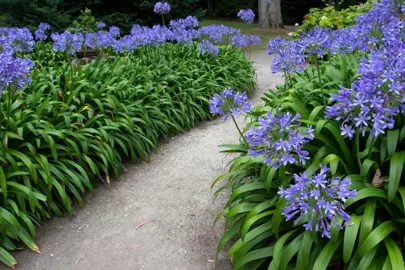
Agapanthus owe their popularity to not just their aesthetics, but also to their versatility. They are commonly mass planted on banks, used to border paths, or grown where other plants often struggle, such as wet areas. They are well suited to planting around living areas, pool, and barbecue areas where they provide both fresh appeal and colour. The foliage is fantastic for providing an element of lushness in a non-dominating, and stylistic manner. The Plant Company often uses them as a foundation planting at the base of short walls, or in mass plantings. They can be included in most garden styles with ease, and make for a pleasant addition.

Agapanthus look amazing when mass planted and are perfect for both banks and borders. The question about how far apart depends on the variety and how quickly you want them to fill an area. For dwarf agapanthus varieties such as Agapetite, these are usually planted 25 cm apart for them to merge, or 40 cm apart if discrete plants are desired. For larger varieties such as Seafoam, they should be planted 60 cm apart to merge, or 1m apart to produce rounded plants. The Plant Company has put a lot of effort into determining how big plants will grow to so our customers get the results they are after. Be sure to check out our range of Agapanthus varieties.

Choose a full sun position for your Agapanthus. The hole should be dug to at least 50-75% deeper and wider than the container the plant is currently growing in. The Plant Company recommends incorporating compost or sheep pellets into the soil to provide additional organic material, but this is not essential. Do not put fertiliser in the bottom of the hole, rather spread Shrub Fertiliser on the soil surface after planting, and preferably do this when the plant is actively growing in spring.
We have specific articles to help you grow amazing Agapanthus: How To Plant Agapanthus, How To Trim Agapanthus, Best Fertiliser For Agapanthus, When To Water Agapanthus, How To Mulch Agapanthus, and Agapanthus Issues And Troubleshooting.

Agapanthus were widely planted on banks and vacant areas to provide dense coverage in times gone by. Unfortunately, the legacy of these clump forming perennials continues as they dominate areas and spread into areas where they are not desired. The challenge then becomes how to get rid of them. Anyone that’s tried to dig out an Agapanthus will know how thick and deep the roots are. When you are wanted to eradicate an entire bank of them, the prospect can be quite daunting.
There are three main options to kill Agapanthus plants recommended by The Plant Company. The first is to dig them out either with a spade or using an excavator. This does have an instantaneous result but leaves a lot of vegetation to clean up. Some spraying with a herbicide may still be necessary if all the roots were not removed.
The second and third options involves chemical control measures. Entire plants can be sprayed with a mixture of metsulfuron-methyl, glyphosate, and Wetcit at label rates. It will take about 2-3 months for the plants to die completely and some respraying may be required, though this is rarely needed. Do not use this mixture if there are plants you wish to keep within the Agapanthus.
The third option is to cut the plants back to near soil level, then paint the cut stems with Vigilant Gel herbicide. One application is generally sufficient but keep an eye out for any regeneration and repeat the cutting and treating process if that occurs. This option won’t impact on plants you wish to keep and is well-suited to when you have several plants to kill. Good luck!

Placing mulch around Agapanthus helps keep the soil moist and significantly reduces weeds. The Plant Company recommends an organic mulch is used as this breaks down over time to provide nutrients and improves the soil. It is also better for the environment than the plastic-based alternatives. Whatever type of mulch is used, it needs to be free draining so the soil can “breathe” and allow water to penetrate quickly and easily. Heavy rates of lawn clippings are therefore not a good option as they hold too much moisture. The Plant Company has three very good options for mulch. The first is coco fibre matting which is made from the husks of coconuts. The second is Earth Mat which is made from recycled paper. Both of these break down to become part of the soil within two years. The third is black plastic matting which will last 20 years or more. Whichever mulch is used, The Plant Company recommends stones, bark chip, or other similar products be spread over top for aesthetic purposes.
Compost is not considered an effective mulch as weeds germinate easily and it is only short lasting. It is, however, a very good method of adding organic matter to the soil and should be applied before the mulch is put down.
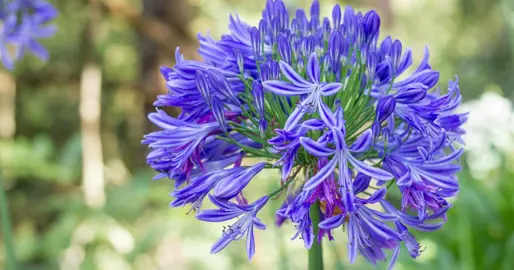
Choose a full sun or partial shade position with good drainage for your Agapanthus plant. The hole should be dug to at least 50-75% deeper and wider than the container the plant is currently growing in. A planting spade makes the hole digging a lot easier. The Plant Company recommends incorporating compost or sheep pellets into the soil to provide additional organic material, but this is not essential. Do not put fertiliser in the bottom of the hole, rather spread that on the soil surface after planting, and preferably do this when the plant is actively growing in spring.
Remove the plant from the container it is growing in by either pulling it free or by cutting the bag. We recommend cutting the bag, especially for larger grade plants, to minimise any chance of damaging the roots. Once out, you need to assess the roots before progressing. If they are not all bound up, and haven’t been growing in a circle within the container, place the plant in the hole without removing any of the growing media or cutting the roots. You can tease them apart if you want but this is not essential. If, however, the roots have been circling the inside of the pot or they look totally root bound, simply cut through those very outer roots on either side. You don’t need to be any more aggressive than this or remove any of the growing media. You can try and tease the roots apart, but this generally breaks them which is why we cut them. NB: cutting roots is not essential, even if the plant is root-bound.
Now place the plant in the hole and make sure it is level with the soil surface before filling in around it. If it is above the soil surface, dig more out. If it is below, put in more soil and retest the level. Once the plant is set level with the soil surface, add more soil gradually and firm it around the plant using gentle pressure as you go. Scatter Shrub Fertiliser across the soil surface after planting and the give the plant a good watering.

Yes, Agapanthus are considered invasive plants. It grows as a large and spreading clump that is largely impenetrable by other plants. Moreover, most produce highly fertile seed that are easily spread. Dwarf varieties such as Agapetite, however, are not regarded as invasive. Please check local government rules ahead of planting if you are concerned.
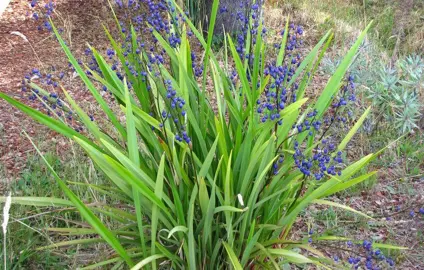
The most common alternatives to Agapanthus are Dianella, flaxes, and Renga Renga Lilies. The plant form and growing requirements are similar with these alternatives.

Only potting mix should be used when plants are grown in a container. Often people will try and cut corners and use soil or mixes that contain both soil and potting mix with poor results. The same applies to when plants are potted up with compost as it holds too much moisture. Soil also contains weeds and tends to become compacted in a container, hence why it is not used in this manner. The Plant Company has nursery grade potting media which is pre-loaded with the correct amounts of fertiliser and micro-nutrients to keep the plant sustained with nutrition and actively growing for the next 12-months. After 12-months, simply add a couple fertiliser tablets to keep the plant fed for the next 12-months.

Agapanthus are best planted from mid-autumn until late spring. During this time, they can cope with the stresses associated with planting (root damage mainly) more easily than if they have to also cope with heat and moisture stress as well. They can be planted in summer provided they are well-watered and the roots have plenty of growing media attached when planted. If watering is a challenge, The Plant Company advises planting any time from late-autumn through until early-spring. Make sure you have a good planting spade to make this job a lot easier.

A full sun or partial shade position is essential for getting the best results with Agapanthus. They can cope with poor drainage but will always grow better with better soil conditions.
In shaded conditions Agapanthus tend to become “leggy” and somewhat “floppy” as the leaves extend and compete with each other to reach light. In full sun they tend to be more compact and denser, with better flower performance and brighter colouring. The planting position should also be moderately sheltered which will help both with establishment and to produce a better shaped plant overall. This is, however, not essential as they can cope well with reasonable wind.
Pruning an Agapanthus plant or even cutting it back takes some thought and planning to ensure you get what you are after. Factors such how hard can I cut them and when should I do it are important considerations. The Plant Company have produced this series of articles to provide advice for pruning Agapanthus in NZ so you can manicure your plants with confidence and success.

Agapanthus will sprout when cut right back, even close to ground level. However, this relies on the plant having heathy shoots at the outset. This activity is best undertaken during spring or summer using secateurs. Please note: Agapanthus grown in shade environments may struggle to re-establish when cut back severely. The Plant Company does not recommend cutting plants any lower than 10 cm above ground level to ensure a better chance of success with this procedure.

Agapanthus are generally only trimmed to remove unsightly leaves or cut back more aggressively to rejuvenate or control a plant. This is best done during spring or summer when plants are moving to active growth. Aggressive trimming usually involves cutting plants back to 5-10 cm above the soil level. Agapanthus are very forgiving plants and even if you get the trimming wrong, they will generally recover! Unfortunately, there is a risk of plants dying after such aggressive trimming. This will sometimes occur if the plants were diseased or suffering nutritional deficiencies ahead of trimming. In these cases, the plant wouldn’t have had the reserves to resume active growth.
Light trimming can involve cutting the brown tips off plants, cutting out yellow or sickly-looking leaves, or even thinning out the foliage. This can be done at any time.

Agapanthus can be trimmed at any time of the year, though spring is the time recommended by The Plant Company for any aggressive cutting back. The plants sprout from the base and at this time of year they are ready to bounce into active growth with the warming weather.
Light trimming to remove unsightly foliage can occur at any time of year.
Watering Agapanthus correctly is an important part of growing amazing plants. Importantly, making sure they get enough without being over-watered is paramount. Our articles provide the know-how on watering Agapanthus in NZ.

Agapanthus require good levels of soil moisture to stay fresh and keep growing actively. They require watering both during establishment and during dry periods. The Plant Company recommends a generous watering every second day during summer, or every third day if the soil is a bit heavier. If plants start to droop, you need to water immediately. The Plant Company advises watering in the morning or in the evening for water conservation purposes.
During dry periods Agapanthus may stop growing to preserve themselves. This is clearly not desirable if you are still wanting them to grow. They will start growing again once rain or water is provided, and provided they have not been allowed to desiccate.
If your Agapanthus is being grown in a pot, watering 2-3 times a week during summer and once every 10 days during winter is the general rule. This will depend on how hot the growing environment is and the size of the plant. The good thing about Agapanthus is that you generally won’t kill them with over-watering.
Enjoy free shipping on orders over $150 along with fast delivery of high-quality plants.
Whether you need assistance finding the plant you’re looking for or you simply want to know more about who we are and what we do, we invite you to get in touch with us today. A member of The Plant Company team will get back in touch as soon as possible.

